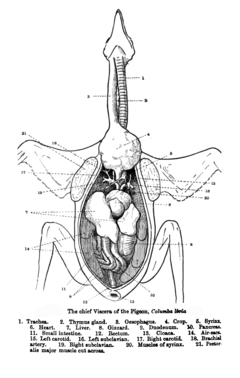.gif)
Crop (anatomy)
Encyclopedia


Digestion
Digestion is the mechanical and chemical breakdown of food into smaller components that are more easily absorbed into a blood stream, for instance. Digestion is a form of catabolism: a breakdown of large food molecules to smaller ones....
that is found in many animals, including gastropods, earthworm
Earthworm
Earthworm is the common name for the largest members of Oligochaeta in the phylum Annelida. In classical systems they were placed in the order Opisthopora, on the basis of the male pores opening posterior to the female pores, even though the internal male segments are anterior to the female...
s, leech
Leech
Leeches are segmented worms that belong to the phylum Annelida and comprise the subclass Hirudinea. Like other oligochaetes such as earthworms, leeches share a clitellum and are hermaphrodites. Nevertheless, they differ from other oligochaetes in significant ways...
es, insect
Insect
Insects are a class of living creatures within the arthropods that have a chitinous exoskeleton, a three-part body , three pairs of jointed legs, compound eyes, and two antennae...
s, bird
Bird
Birds are feathered, winged, bipedal, endothermic , egg-laying, vertebrate animals. Around 10,000 living species and 188 families makes them the most speciose class of tetrapod vertebrates. They inhabit ecosystems across the globe, from the Arctic to the Antarctic. Extant birds range in size from...
s, and even some dinosaur
Dinosaur
Dinosaurs are a diverse group of animals of the clade and superorder Dinosauria. They were the dominant terrestrial vertebrates for over 160 million years, from the late Triassic period until the end of the Cretaceous , when the Cretaceous–Paleogene extinction event led to the extinction of...
s.
Bees
Cropping is used by bees to temporarily store nectar of flowers. When bees "suck" nectar, it is stored in their crop.Birds
In a bird's digestive system, the crop is an expanded, muscular pouch near the gullet or throat. It is a part of the digestive tract, essentially an enlarged part of the esophagusEsophagus
The esophagus is an organ in vertebrates which consists of a muscular tube through which food passes from the pharynx to the stomach. During swallowing, food passes from the mouth through the pharynx into the esophagus and travels via peristalsis to the stomach...
. As with most other organisms that have a crop, the crop is used to temporarily store food. Not all birds have a crop. In adult doves and pigeons, the crop can produce crop milk
Crop milk
Crop milk is a secretion from the lining of the crop of parent birds that is regurgitated to young birds. They are found among all pigeons and doves where they are referred to as pigeon milk...
to feed newly hatched birds.
Scavenging birds, such as vulture
Vulture
Vulture is the name given to two groups of convergently evolved scavenging birds, the New World Vultures including the well-known Californian and Andean Condors, and the Old World Vultures including the birds which are seen scavenging on carcasses of dead animals on African plains...
s, will gorge themselves when prey is abundant, causing their crop to bulge. They subsequently sit, sleepy or half torpid, to digest their food.
Most raptors have one; like falcons, hawks, eagles and vultures (as stated above) but owls do not.
See also
- EsophagusEsophagusThe esophagus is an organ in vertebrates which consists of a muscular tube through which food passes from the pharynx to the stomach. During swallowing, food passes from the mouth through the pharynx into the esophagus and travels via peristalsis to the stomach...
- ProventriculusProventriculusThe proventriculus is part of the digestive system of birds, invertebrates and insects.-Birds:The proventriculus is a standard part of avian anatomy...
- GizzardGizzardThe gizzard, also referred to as the ventriculus, gastric mill, and gigerium, is an organ found in the digestive tract of some animals, including birds, reptiles, earthworms and some fish. This specialized stomach constructed of thick, muscular walls is used for grinding up food; often rocks are...
- Gular pouch, in bird anatomy, a flap generally used to store fish and other prey while hunting

